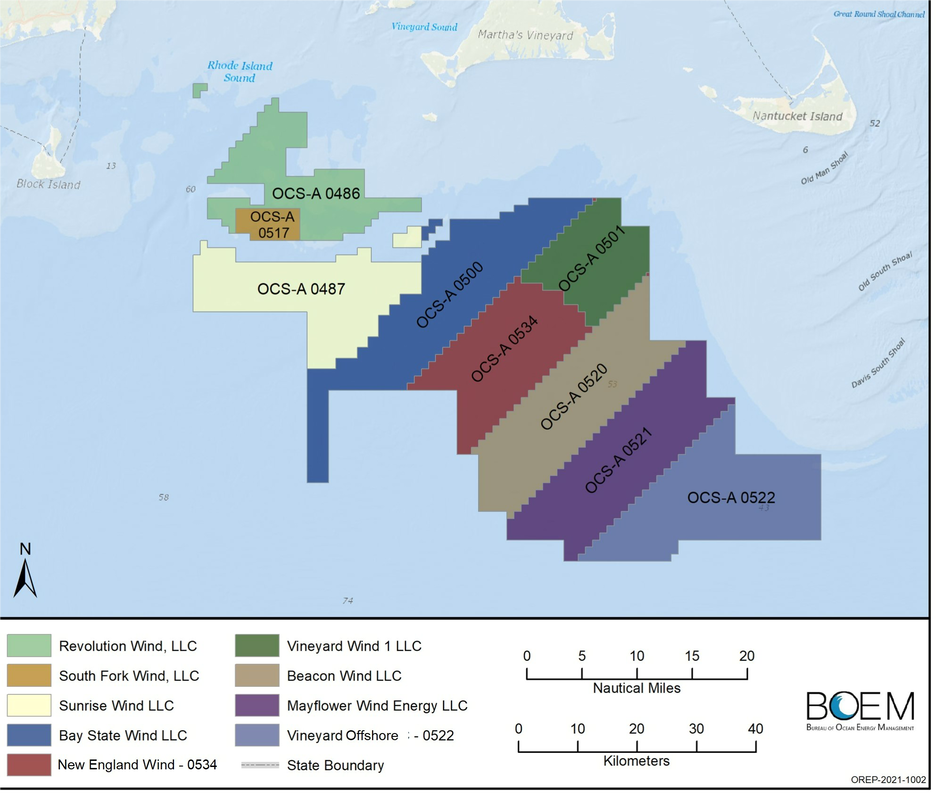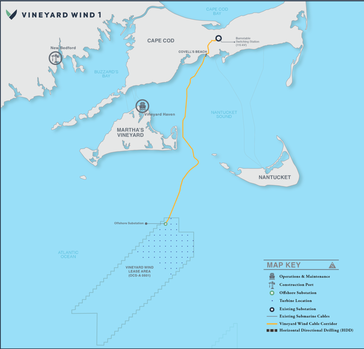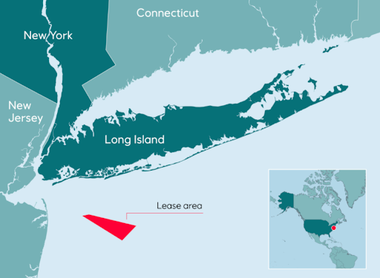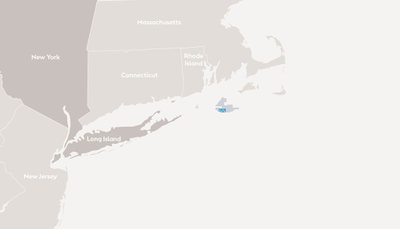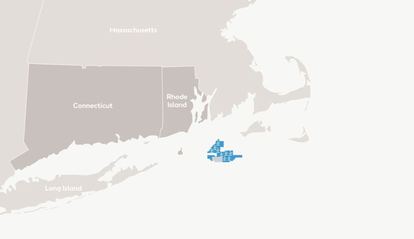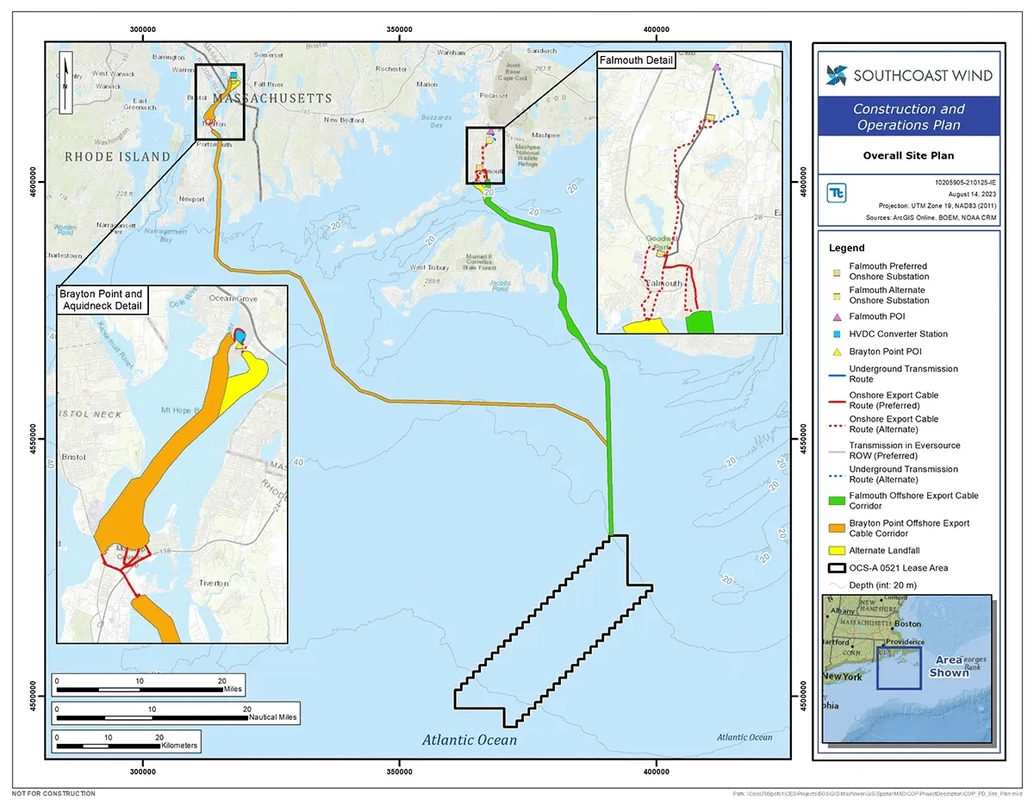Fishing Industry Concerns
1. Industry believes that there is political pressure on BOEM to develop Offshore Wind quickly. There are concerns that BOEM will issue permits based on currently available information that will become inadequate and out-of-date once construction begins.
2. From a strictly operational viewpoint, placing turbines close to shore would lower construction cost, reduce maintenance and power transmission cost, as well as reduce impacts to fishermen. However, landowners do not want to look at turbines in the sea. Leasing areas of historical fishing grounds for the purposes of offshore wind development will displace fishermen and force them to be the primary interest group and “collateral damage” as the US moves to develop offshore wind.
3. The fishing industry has expressed concern that the tradition of fishing, which is important to N.E.’s cultural heritage, is being lost. Although wind development is not the major contributor to the decline in fishing, it is yet another “nail in the coffin” for this industry. Thus, making it extremely difficult to maintain a healthy fishery.
4. The Industry is deeply concerned that the overall impacts of offshore wind will be negative for fishermen and the ecosystems they rely on. These impacts cannot be predicted with a level of confidence that fishermen will be able to survive.
5. The uncertainty about the impacts of wind energy development is a major reason why the industry is opposed to it. Before fishermen endorse wind development, they want a complete understanding and sound science of the impacts on; fish survival and behavior, habitats fish rely on to survive, safety and navigation, social and economic impacts to fisheries and the ports they rely on, and the cumulative impacts of multiple development projects in a short time frame. In their view, the data is inaccurate, inconclusive, not collected correctly, nor collected on a sufficiently fine scale to be useful in determining impacts.
6. The industry is frustrated that wind development is being forced upon them at an inconvenient time, after fishermen have been constrained over the past two decades to rebuild fish stocks. Now that the sacrifices are beginning to bear fruit, the industry is concerned that they will have to accept further constraints due to construction and operations of the wind turbines. Not to mention, potential of causing irreparable harm to the rebuilt stocks, causing a fish stock decline and economic hardship.
7. Industry is concerned that wind farms could become de facto marine protected areas, from which fishing is excluded. If a serious accident were to occur, causing loss of life, property and or major damage to a wind turbine, there may be a risk that all fishing will be prohibited by the Fed. Gov’t or the marine insurers for safety precautions, thus further displacing fishermen.
8. There is a major lack of involvement of industry members in the planning process, particularly the ability to influence the final decisions on wind farm construction, turbine layout and operations. This has caused a lack of engagement by the industry; the feeling is we met with the industry (check the box) but no one is interested or listening. For a true collaboration, fishermen need to be an integral part of the planning and decision-making process, not just occasional advisors. An appropriate quote, “If you’re not at the table, you are on the Menu.”
9. Major long-term research is paramount and should be funded collectively by all Wind Farm Developers, with the funds managed by a Non-Profit Foundation with a history of working collaboratively with Academia, NEFSC and Fishing Industry. Forming a working group of academia, scientists, managers, and stakeholders to set research priorities is necessary. Research must commence pre-construction to assess baseline of fish stocks, during construction and monitoring phases, and long-term phases of 15 years or more to measure impacts and form mitigation strategies.
10. In recent years, fishermen have observed that the geotechnical and geophysical surveys conducted by the multiple developers negatively impact their catches. During and after the geotechnical and geophysical surveys take place in an area, fishermen’s catches are greatly reduced. Because of this, the industry feels it is imperative that baseline studies need to take place prior to any geotechnical and geophysical survey work to get a true and accurate assessment of the impacts.
11. It is important to establish a collaborative plan for damage to fishing gear and power cables, with an appropriate protocol for proof of damage, cost, down time, etc. utilizing a knowledgeable fishing industry representative and wind developer liaison to determine fair mitigation.
12. Additional Industry concerns; loss of fishing grounds during construction, acoustical noise ring impact from pile driving on specific fish species and their larvae, Electromagnetic Fields and Low Frequency Noise of Fish Stocks, Scouring around the base of the mono-pilings, contaminated dredge spoils from pile driving, suspended sediment settling impacts /benthic/ shellfish, burying of transmission cables, timing of construction, spacing of turbines for mobile gear to fish and transit lanes to and from traditional fishing grounds, safety concerns, radar double imaging and spoking, additional cost of conducting business, communications, and decommissioning.
2. From a strictly operational viewpoint, placing turbines close to shore would lower construction cost, reduce maintenance and power transmission cost, as well as reduce impacts to fishermen. However, landowners do not want to look at turbines in the sea. Leasing areas of historical fishing grounds for the purposes of offshore wind development will displace fishermen and force them to be the primary interest group and “collateral damage” as the US moves to develop offshore wind.
3. The fishing industry has expressed concern that the tradition of fishing, which is important to N.E.’s cultural heritage, is being lost. Although wind development is not the major contributor to the decline in fishing, it is yet another “nail in the coffin” for this industry. Thus, making it extremely difficult to maintain a healthy fishery.
4. The Industry is deeply concerned that the overall impacts of offshore wind will be negative for fishermen and the ecosystems they rely on. These impacts cannot be predicted with a level of confidence that fishermen will be able to survive.
5. The uncertainty about the impacts of wind energy development is a major reason why the industry is opposed to it. Before fishermen endorse wind development, they want a complete understanding and sound science of the impacts on; fish survival and behavior, habitats fish rely on to survive, safety and navigation, social and economic impacts to fisheries and the ports they rely on, and the cumulative impacts of multiple development projects in a short time frame. In their view, the data is inaccurate, inconclusive, not collected correctly, nor collected on a sufficiently fine scale to be useful in determining impacts.
6. The industry is frustrated that wind development is being forced upon them at an inconvenient time, after fishermen have been constrained over the past two decades to rebuild fish stocks. Now that the sacrifices are beginning to bear fruit, the industry is concerned that they will have to accept further constraints due to construction and operations of the wind turbines. Not to mention, potential of causing irreparable harm to the rebuilt stocks, causing a fish stock decline and economic hardship.
7. Industry is concerned that wind farms could become de facto marine protected areas, from which fishing is excluded. If a serious accident were to occur, causing loss of life, property and or major damage to a wind turbine, there may be a risk that all fishing will be prohibited by the Fed. Gov’t or the marine insurers for safety precautions, thus further displacing fishermen.
8. There is a major lack of involvement of industry members in the planning process, particularly the ability to influence the final decisions on wind farm construction, turbine layout and operations. This has caused a lack of engagement by the industry; the feeling is we met with the industry (check the box) but no one is interested or listening. For a true collaboration, fishermen need to be an integral part of the planning and decision-making process, not just occasional advisors. An appropriate quote, “If you’re not at the table, you are on the Menu.”
9. Major long-term research is paramount and should be funded collectively by all Wind Farm Developers, with the funds managed by a Non-Profit Foundation with a history of working collaboratively with Academia, NEFSC and Fishing Industry. Forming a working group of academia, scientists, managers, and stakeholders to set research priorities is necessary. Research must commence pre-construction to assess baseline of fish stocks, during construction and monitoring phases, and long-term phases of 15 years or more to measure impacts and form mitigation strategies.
10. In recent years, fishermen have observed that the geotechnical and geophysical surveys conducted by the multiple developers negatively impact their catches. During and after the geotechnical and geophysical surveys take place in an area, fishermen’s catches are greatly reduced. Because of this, the industry feels it is imperative that baseline studies need to take place prior to any geotechnical and geophysical survey work to get a true and accurate assessment of the impacts.
11. It is important to establish a collaborative plan for damage to fishing gear and power cables, with an appropriate protocol for proof of damage, cost, down time, etc. utilizing a knowledgeable fishing industry representative and wind developer liaison to determine fair mitigation.
12. Additional Industry concerns; loss of fishing grounds during construction, acoustical noise ring impact from pile driving on specific fish species and their larvae, Electromagnetic Fields and Low Frequency Noise of Fish Stocks, Scouring around the base of the mono-pilings, contaminated dredge spoils from pile driving, suspended sediment settling impacts /benthic/ shellfish, burying of transmission cables, timing of construction, spacing of turbines for mobile gear to fish and transit lanes to and from traditional fishing grounds, safety concerns, radar double imaging and spoking, additional cost of conducting business, communications, and decommissioning.
Key Documents:
- Low-frequency sounds induce acoustic trauma in cephalopods
- Anthropogenic noise pollution from pile-driving disrupts the structure and dynamics of fish shoals
- Obligations and aspirations: A critical evaluation of offshore wind farm cumulative impact assessments
- Offshore wind farms – ecological effects of noise and habitat alteration on fish
- Collection of articles on wind farms and radar
- Onset of barotrauma injuries related to number of pile driving strike exposures in hybrid striped bass
- Environmentalists link whale beachings to offshore windfarm sonar
- Twenty-Five Industrial Wind Energy Deceptions
- US Coast Guard Port Access Route Study
- Final Environmental Impact Statement for Vineyard Wind 1
- Draft Environmental Impact Statement for South Fork
MA/RI Wind Developers:
Vineyard Wind
Active Mariner Updates: Find Mariner Updates Here Fisheries Frequently Asked Questions Sign up for Vineyard Wind Mariner Updates Beacon Wind: Beacon Wind is a wind energy project through BP within the RI/MA wind energy lease areas. Learn more about the project here: Beacon Wind |
|
Empire Wind: Empire Wind is a wind energy project through Equinor located in the NY bight area. Learn more about the project here: Empire Wind You can also join the EW Fisheries Facebook Page for updates and more information about the project: EW Fisheries Facebook Group Page |
Orsted
|
South Fork: South Fork is a project located in the RI/MA wind energy lease areas with energy to go to Long Island New York. This project will be located in an area critical to commercial and recreational fishing. Learn more about the project here: South Fork Wind. Find active mariner updates here. |
|
Revolution Wind:
Revolution Wind is a project also located in the RI/MA wind energy area. For this project, 400 MW will go to RI and 304 MW to CT. Construction activities are expected to begin in 2023. Find more details about the project here: Revolution Wind (revolution-wind.com) Find active mariner updates here. |

